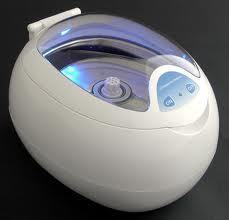How Optical Ultrasonic Cleaners Work
Optical Ultrasonic Cleaners (sometimes referred to as Supersonic Cleaners) are electronic devices that use the power of ultrasound to clean items that are fragile or delicate. Ultrasound is sound waves that usually measure from 15-400 kHz. These sound frequencies have specific attributes that are beneficial in removing dirt and other forms of residue from a variety of materials. While most ultrasonic cleaners are used to clean a variety of items including, jewelry, surgical materials, clock parts and small electrical components, many ultrasonic cleaners are specifically created to clean optical items such as contact lenses, eye glasses and professional optical components.
For the most part, optical ultrasonic cleaners are relatively small devices that are about the size of a computer mouse, other devices specifically made for cleaning jewelry or small optical components are usually bigger- about the size of a toaster. Every optical ultrasonic cleaner has a chamber in which ultrasonic conducting fluid is placed. It should be noted that for optical ultrasonic cleaners specifically made for cleaning contact lenses, normal contact lens solution can be used. If you are using an optical ultrasonic cleaner to clean optical components or eye glasses, besides using contact lens solution, you can also use a liquid organic solvent or specialized optical ultrasonic cleaning solution.
Once you place the item which you wish to clean in the optical ultrasonic cleaner chamber, you can close the top of the cleaner; set the time and cleaning settings and begin the cleaning process. While some optical ultrasonic cleaners have preset frequencies in which they operate at, professional and industrial optical ultrasonic cleaners can easily be changed along with the sound wave frequency and time limit.
Within the device is a transducer that creates ultrasound waves in the fluid. These waves are created and then collapse in very short periods of time, creating tiny bubbles. The bubbles along with the cleaning solution help break off dirt and residue and remove it from the item being cleaned. It should be noted that the frequency of the sound waves plays an important part in how well an item is cleansed. For instance, an extremely high sound wave of 400 kHz creates extremely small bubbles that can reach inside tiny crevices on the item and remove dirt and residue. In many instances, extremely high temperatures and high amounts of pressure are created, however since the bubbles are microscopic, their effects are limited.
Optical ultrasonic cleaners are one of the most efficient and effective ways to clean ordinary or specialized optical components. While each machine can vary, many contact lens optical ultrasonic cleaners only require about a 2 minute cycle for a thorough cleaning. Optical ultrasonic cleaners are one of the best ways to clean contact lenses and are perfect for those that would like to bypass using harsher chemicals to clean their lenses. These types of cleaners are also affordable. For contact lens cleaners, expect to pay $20 to $50, however for professional or industrial use optical ultrasonic cleaners, prices can be more than $1,000.


Comments - No Responses to “How Optical Ultrasonic Cleaners Work”
Sorry but comments are closed at this time.